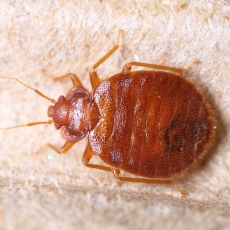
Bed bugs bite you and feed on your blood. You may have no reaction to the bites, or you may have small marks or itching. Severe allergic reactions are rare. Bed bugs don't transmit or spread diseases.
Adult bed bugs are brown, 1/4 to 3/8 inch long, and have a flat, oval-shaped body. Young bed bugs (called nymphs) are smaller and lighter in color. Bed bugs hide in a variety of places around the bed. They might also hide in the seams of chairs and couches, between cushions, and in the folds of curtains. They come out to feed about every five to ten days. But they can survive over a year without feeding.
- Bed Bugs (National Library of Medicine)Bed bugs bite you and feed on your blood. You may have no reaction to the bites, or ... marks or itching. Severe allergic reactions are rare. Bed bugs don't transmit or spread diseases. Adult bed ...
- Bed Bugs FAQs (Centers for Disease Control and Prevention)Frequently asked questions about bed bugs. ... bed bugs, FAQs, frequently asked questions, Parasitic Diseases ... Bed Bugs/Start Here ... Bed Bugs ... Centers for Disease ...
- Biting Insects: Bed Bugs (University of Minnesota Extension)Bed Bugs/Prevention and Risk Factors ... Bed Bugs ... Control bed bugs in homes ... University of Minnesota Extension
- Top Ten Tips to Prevent or Control Bed Bugs (Environmental Protection Agency)Bed Bugs/Prevention and Risk Factors ... Bed Bugs ... Environmental Protection Agency ... Confirm you have bed bugs rather than other insects (if needed, show to your ...
- How to Find Bed Bugs (Environmental Protection Agency)Bed Bugs/Prevention and Risk Factors ... Bed Bugs ... Environmental Protection Agency ... Find and correctly identify an infestation early before it becomes widespread. ...
- Do-It-Yourself Bed Bug Control (Environmental Protection Agency)Controlling bed bugs is complex. Using an integrated pest management (IPM) approach incorporates both non-chemical and pesticide methods. Success ...
- Find a Bed Bug Pesticide Product (Environmental Protection Agency)Introduces the Bed Bug Product Search Tool, to help consumers find EPA-registered pesticides for bed bug infestation control. Inclusion in this database is not ...
- Protecting Yourself from Bed Bugs in Public Places (Environmental Protection Agency)Bed Bugs/Related Issues ... Bed Bugs ... Environmental Protection Agency ... Infestations in non-residential areas are rare, but may still present opportunities for ...
- Getting Rid of Bed Bugs (Environmental Protection Agency)Bed Bugs/Treatments and Therapies ... Bed Bugs ... Environmental Protection Agency ... It is most effective to use a combination of chemical (pesticides) and non-chemical ...
- Introduction to Bed Bugs (Environmental Protection Agency)The common bed bug (Cimex lectularius) is a pest – feeding on blood, causing itchy bites and generally irritating their human hosts. EPA and other agencies all consider bed bugs a public health pest, but bed bugs are ...



